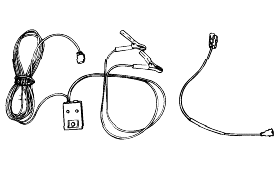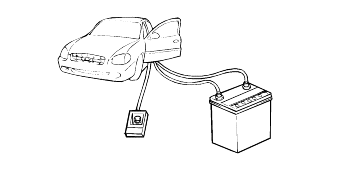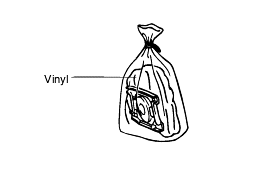Tool, Number, Name
Use
Deployment tool (0957A-34100A)
SRS DEPLOYMENT ADAPTER HARNESS
DAB, BPT : 0957A-38500
PAB, SAB : 0957A-38100

Deployment inside the vehicle (if the vehicle will no longer be driven)
DTC No. | Fault description |
B1111 | Battery voltage too high |
B1112 | Battery voltage too low |
B1346 | Driver airbag (DAB), Resistance too high |
B1347 | Driver airbag (DAB), Resistance too low |
B1348 | Driver airbag (DAB), Short to ground |
B1349 | Driver airbag (DAB), Short to Battery |
B1352 | Passenger airbag (PAB), Resistance too high |
B1353 | Passenger airbag (PAB), Resistance too low |
B1354 | Passenger airbag (PAB), Short to ground |
B1355 | Passenger airbag(PAB), Short to Battery |
B1361 | Driver seat belt pretensioner (DBPT), Resistance too high |
B1362 | Driver seat belt pretensioner (DBPT), Resistance too low |
B1363 | Driver seat belt pretensioner (DBPT), Short to ground |
B1364 | Driver seat belt pretensioner (DBPT), Short to Battery |
B1367 | Passenger seat belt pretensioner (PBPT), Resistance too high |
B1368 | Passenger seat belt pretensioner (PBPT), Resistance too low |
B1369 | Passenger seat belt pretensioner (PBPT), Short to ground |
B1370 | Passenger seat belt pretensioner (PBPT), Short to Battery |
B1620 | Internal fault |
B1650 | Crash recorded (Replace SRE-LC) |
B1661 | ECU mismatching (Replace SRE-LC) |
B2500 | Warning lamp failure |
The DAB is located in the steering wheel.
The PAB is located in the crash pad.
DTC No. | Fault description |
B1111 | Battery voltage too high |
B1112 | Battery voltage too low |
B1346 | Driver airbag (DAB), Resistance too high |
B1347 | Driver airbag (DAB), Resistance too low |
B1348 | Driver airbag (DAB), Short to ground |
B1349 | Driver airbag (DAB), Short to Battery |
B1352 | Passenger airbag (PAB), Resistance too high |
B1353 | Passenger airbag(PAB), Resistance too low |
B1354 | Passenger airbag (PAB), Short to ground |
B1355 | Passenger airbag (PAB), Short to Battery |
B1378 | Driver side airbag (DSAB), Resistance to high |
B1379 | Driver side airbag (DSAB), Resistance to low |
B1380 | Driver side airbag (DSAB), Short to ground |
B1381 | Driver side airbag (DSAB), Short to Battery |
B1382 | Passenger side airbag (PSAB), Resistance too high |
B1383 | Passenger side airbag (PSAB), Resistance too low |
B1384 | Passenger side airbag (PSAB), Short to ground |
B1385 | Passenger side airbag (PSAB), Short to Battery |
B1361 | Driver seat belt pretensioner (DBPT), Resistance too high |
B1362 | Driver seat belt pretensioner (DBPT), Resistance too low |
B1363 | Driver seat belt pretensioner (DBPT), Short to ground |
B1364 | Driver seat belt pretensioner (DBPT), Short Battery |
B1367 | Passenger seat belt prestensioner (PBPT), Resistance too high |
B1368 | Passenger seat belt prestensioner (PBPT), Resistance too low |
B1369 | Passenger seat belt prestensioner (PBPT), Short to ground |
B1370 | Passenger seat belt prestensioner (PBPT), Short to Battery |
B1401 | Satellite left side short to ground |
B1402 | Satellite left side short to Battery |
B1400 | Satellite left side defect |
B1404 | Satellite right side short to ground |
B1405 | Satellite right side short to Battery |
B1403 | Satellite right side defect |
B1408 | Satellite left communication error |
B1409 | Satellite right communication error |
B1620 | Internal fault |
B1650 | Crash recorded (Replace SRE-HMC) |
B1651 | Crash redcorded driver side airbag |
B1652 | Crash recorded passenger side airbag |
B1661 | ECU mismatchign (Replace SRE-HMC) |
B2500 | Warning lamp failure |
The DAB is located in the steering wheel.
The PAB is located in the crash pad.
The DSAB is located in the left side of driver's seat.
The PSAB is located in the right side of passenger's seat.
When handling the deployed airbag be careful that not the dust enters your eyes and always wear gloves to avoid direct contact with the dust.
Tool, Number, Name | Use |
Deployment tool (0957A-34100A) SRS DEPLOYMENT ADAPTER HARNESS DAB, BPT : 0957A-38500 PAB, SAB : 0957A-38100  | Deployment inside the vehicle (if the vehicle will no longer be driven) |
CASE | DISPOSAL PLAN | |
Abnormal problems in airbag module | Deploy and discard | |
Car scrapping | DAB, PAB, BPT | Deploy the airbag module with the SST |
Crash (Deployed) | Discard | |
If the vehicle is to be scrapped, junked, or otherwise disposed of, deploy the airbag inside the vehicle.
Since there is a loud noise when the airbag is deployed, avoid residential areas whenever possible. If anyone is nearby, give warning ofthe impending noise.
Since a large amount of smoke is produced when the airbag is deployed, select a well-ventilated site. Moreover, never attempt the test near a fireor smoke sensor.
When vehicle will no longer be driven :
Open all windows and doors of the vehicle. Move the vehicle to an isolated spot.
Disconnect the negative (-) and positive (+) battery cables from the battery terminals, and then remove the battery from the vehicle
Wait at least 30 seconds after disconnecting the battery cable before doing any further work.
Remove the center crash pad side cover.
Remove the Airbag SRSCM connector.
Connect the deployment tool to the connector of each module.

As far away from the vehicle as possible, press the push button on the deployment tool to deploy the airbag.

Before deploying the airbag in this manner, first check to be sure that there is no one in or near the vehicle. Wear safety glasses.
The inflator will be quite hot immediately following the deployment, so wait at least 30 minutes to allow it to cool before attempting to handle it. Although not poisonous, do not inhale gas from airbag deployment. See the Deployed Airbag Module Disposal Procedures for post-deployment handlinginstructions.
If the airbag fails to deploy when the procedures above are followed, do not go near the module. Contact your DPSM.
The inflator will be quite hot immediately following deployment, so wait at least 30 minutes to allow it to cool before attempting to handle it.
Do not put water or oil on the airbag after deployment.
There may be adhered to the deployed airbag module, material that could irritate the eyes and/or skin, so wear gloves and safety glasses when handling a deployed airbag module. If despite these precautions, the material does get into your eyes or on your skin, immediately rinse the affected area with a large amount of clean water. If any irritation develops, seek medical attention.
Tightly seal the airbag module in a strong vinyl bag for disposal.

Be sure to always wash your hands after completing this operation.